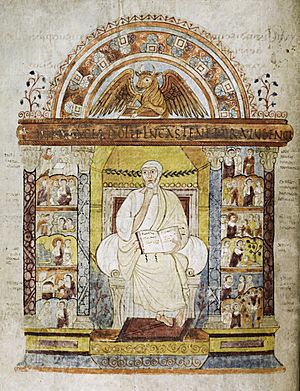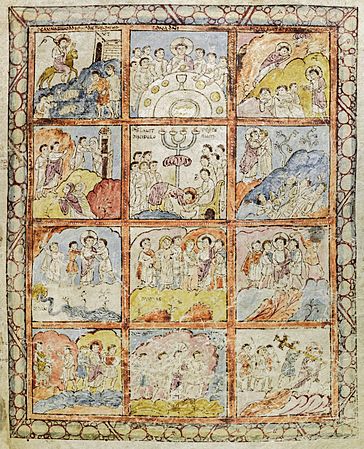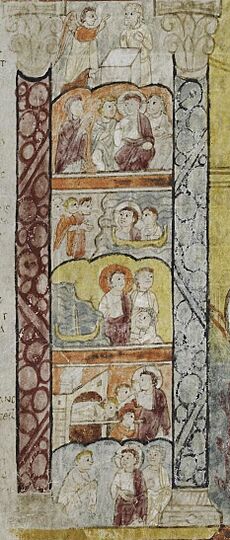St Augustine Gospels facts for kids

The St Augustine Gospels is a very old and beautiful decorated book from the 6th century. It is kept at Corpus Christi College, Cambridge in England. This book is a Gospel Book, which means it contains the four Gospels from the Bible. It was made in Italy and came to England not long after it was created. For almost 1,000 years, it was likely kept in Canterbury.
This manuscript is special because it's the oldest surviving illustrated Gospel Book written in Latin. Most other old Gospel books are in Greek or Syriac. It's also one of the oldest books in Europe that still exists! Even though only two full-page pictures remain, they are very important for understanding art history. When this book was made, Latin was still commonly spoken.
The Church of England sometimes calls this book the Canterbury Gospels. However, experts usually use that name for a different, later book from the 8th century.
Contents
History of the Gospels
Many people believe this book was brought to England by St Augustine himself in 597 AD. He came on a special trip called the Gregorian mission. Others think it was one of the books sent to him by Pope Gregory the Great in 601 AD. Experts like Kurt Weitzmann agree that this story is very likely true.
The main part of the book was written in a special Italian style of writing called uncial. This writing style shows the book was made in the 6th century. Places like Rome or Monte Cassino are thought to be where it was created. By the late 7th or early 8th century, the book was definitely in England. At that time, some corrections and notes were added in an English writing style.
The book was kept at St Augustine's Abbey, Canterbury by the 10th century. Later, in the Middle Ages, it was not kept in the library. Instead, it lay on the altar, used for important church ceremonies.
In 1575, Matthew Parker, who was the Archbishop of Canterbury, gave the manuscript to the Parker Library, Corpus Christi College, Cambridge. This happened after many monasteries were closed down. The St Augustine Gospels have a special role in the Church of England. They are traditionally used when new Archbishops of Canterbury are sworn into office. This tradition was brought back in 1945. The book is taken to Canterbury Cathedral for each ceremony.
The Gospels have also been used for other big events. These include the visit of Pope John Paul II in 1982. They were also used for the 1,400th anniversary of the Gregorian mission in 1997. In 2023, the book was carried in the procession for the coronation of Charles III and Camilla. This was the first time it was used in a coronation. For this event, the book was open to the page showing the portrait of Saint Luke.
The book was rebound, or given a new cover, in 1948–49. It now has plain oak covers and a spine made of cream-colored goatskin.
The Text Inside
The St Augustine Gospels is one of the oldest and most complete copies of Jerome's translation of the Gospels. Jerome's translation, called the Vulgate, was made in the late 4th century. It slowly replaced an older Latin text called the Vetus Latina.
In 1933, an expert named Hermann Glunz studied the St Augustine Gospels. He found about 700 small differences from the standard Vulgate text. Most of these were minor spelling or word order changes. But sometimes, the person who copied the book chose words from the older Vetus Latina. This supports the idea that Pope Gregory the Great might have given the book. He wrote that he used the Vulgate but sometimes preferred the Old Latin for certain parts.
Amazing Pictures (Miniatures)
This manuscript once had pictures of all four Gospel writers. These pictures usually came before their Gospel in the book. It also had at least three more pages with story scenes. Only the two pages before Luke's Gospel have survived.
However, the twenty-four small scenes that remain are very rare. They show parts of the Life of Christ. These pictures are very important for understanding Christian iconography (the study of images). They are special because they come from the old Western Roman Empire. Other similar story pictures from this time are mostly Greek or Syriac.
The pictures in this book look different from older classical art. They have a "linear style," which means they use strong lines. This style makes the figures look flatter. It also starts to show a rhythmic design, which is an early step towards more abstract art. For another historian, the figures look "medieval" and are more like "tinted drawings" than paintings.
Experts have often wondered how these pictures influenced later Anglo-Saxon art in England. Since many of the original picture pages are lost, it's hard to know for sure. However, it's clear that other art styles from Europe were also available in England. Later works, like the Stockholm Codex Aureus, might have been influenced by the Augustine Gospels.
Luke's Portrait
Only the portrait page for Luke has survived (on page 129v). Luke is shown sitting on a marble throne with a cushion. He is in a fancy building setting. This kind of setting was common in old Roman art. His pose, with his chin resting on his hand, suggests he is thinking deeply. Above him is a winged ox, which is Luke's special symbol.
There is also a Latin phrase above the picture. It comes from a poem by Coelius Sedulius and means: "Luke holds the laws of priesthood in the mouth of the young bull."
What's unusual are the twelve small scenes around Luke's portrait. They show parts of the Works of Christ. Jesus is easy to spot because he is the only figure with a halo. These scenes are placed between columns in the building frame. This arrangement is unique for early portraits like this. The scenes themselves might have been inspired by old wall paintings in Rome.
Many of these scenes were rarely shown in art later in the Middle Ages. They include:
- The Annunciation to Zechariah (Luke 1, 8–20)
- Christ among the Doctors (Luke 2, 43–50)
- Christ preaching from the boat (Luke 5, 3)
- The Calling of Peter (Luke 5, 8)
- The Miracle of the son of the widow of Naim (Luke 7, 12–16)
- The Calling of Matthew (Luke 5, 27–32)
- A lawyer asking Jesus about eternal life (Luke 10, 25)
- A woman from the crowd speaking to Jesus (Luke 11, 27–28)
- The Miracle of the Bent Woman (Luke 13, 10–17)
- One leper out of ten being healed (Luke 17, 12–19)
- The Healing of the Man with Dropsy (Luke 14, 2–5)
- The Calling of Zacchaeus (Luke 19, 1–10)
Notes were added in the margins later, probably in the 8th century. These notes name the scenes or quote from Luke's Gospel. For example, a note says: "a lawyer stood up, tempting him."
Passion Scenes

On page 125r, there is a full-page picture with twelve story scenes. These are mostly from the Passion (the story of Jesus's suffering and death). The Raising of Lazarus is also included. This miracle was seen as a reason why the Jewish leaders decided to act against Jesus.
The Crucifixion itself is not shown. The story ends with Christ carrying the Cross. It is thought that at least two more such pages existed at the start of other Gospels. A page before the Gospel of John might have finished the Passion and Resurrection story. The scenes around Luke's portrait avoid major events like Jesus's birth or baptism. These events were likely shown on other picture pages.
Compared to other art from that time, these Passion scenes focus more on Jesus's suffering. This might have been influenced by art from the Eastern Roman Empire. It also shows how Western art would depict these scenes in the future.
From top left, the twelve scenes shown are:
- Christ's entry into Jerusalem
- Last Supper, showing the first Eucharist
- Agony in the Garden of Gethsemane
- Raising of Lazarus
- Washing of feet
- Betrayal of Christ
- Arrest of Jesus
- Sanhedrin Trial of Jesus
- Mocking of Christ
- Pontius Pilate washes his hands
- Christ led from Pilate
- Simon of Cyrene helps Christ carrying the Cross
Most of these scenes remained very common in art throughout the Middle Ages. The Raising of Lazarus was easy to recognize because of the white cloth around the body. The Hand of God in the Agony in the Garden is the earliest known example of this symbol in that scene.


